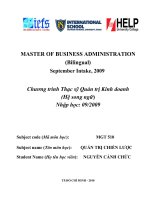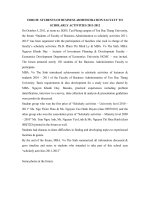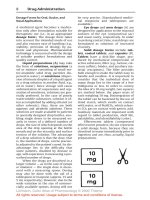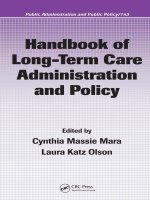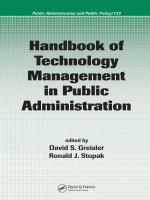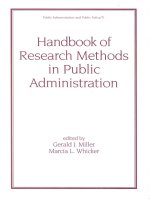handbook of drug administration via enteral feeding tubes
Bạn đang xem bản rút gọn của tài liệu. Xem và tải ngay bản đầy đủ của tài liệu tại đây (5.42 MB, 590 trang )
Rebecca White and Vicky Bradnam
An enteral feeding tube provides a means of maintaining nutritional
intake when there is limited access to the gastrointestinal tract. The
use of enteral feeding tubes has increased for both short and long
term feeding in both primary and secondary care due to the increase
in awareness of the importance of adequate nutritional intake.
Handbook of Drug Administration via Enteral Feeding Tubes is a
practical guide to the safe administration of medicines via enteral
feeding tubes. Ten chapters provide the background knowledge to
inform clinical decisions, and the accompanying 344 monographs
contain guidance on the safe administration of specific drugs and
formulations.
Contents include: types of enteral feeding tubes, tube flushing,
restoring and maintaining patency, drug therapy review, medication
formulation choice, unlicensed medication use, health and safety
and interactions.
Handbook of Drug Administration via Enteral Feeding Tubes is an
essential guide for pharmacists, doctors, nurses, dieticians,
and also for nursing homes and hospices.
Rebecca White is Lead Pharmacist, Nutrition and Surgery,
Oxford Radcliffe Hospitals NHS Trust, Oxford, UK.
www.pharmpress.com
on behalf of the
British Pharmaceutical
Nutrition Group
AdminEntFINALFINAL.indd 1
Handbook of
Drug Administration via
Enteral Feeding Tubes
Rebecca White and Vicky Bradnam
White and Bradnam
Vicky Bradnam is Chief Pharmacist, Bromley Hospitals NHS Trust,
Kent, UK.
Handbook of Drug Administration via Enteral Feeding Tubes
Handbook of Drug Administration
via Enteral Feeding Tubes
on behalf of the
British Pharmaceutical
Nutrition Group
2/11/06 09:20:13
01_1603PP_FM.qxd
26/10/06
7:56 pm
Page i
Handbook of Drug Administration
via Enteral Feeding Tubes
01_1603PP_FM.qxd
26/10/06
7:56 pm
Page ii
01_1603PP_FM.qxd
26/10/06
7:56 pm
Page iii
Handbook of Drug
Administration via
Enteral Feeding Tubes
Rebecca White
BSc (Hons) MSc MRPharmS
Lead Pharmacist; Nutrition and Surgery,
Oxford Radcliffe Hospitals NHS Trust, Oxford, UK
Vicky Bradnam
BPharm (Hons) ClinDip MBA Open MRPharmS
Chief Pharmacist, Bromley Hospitals NHS Trust, Kent, UK
On behalf of the British Pharmaceutical Nutrition Group
London
●
Chicago
01_1603PP_FM.qxd
26/10/06
7:56 pm
Page iv
Published by the Pharmaceutical Press
An imprint of RPS Publishing
1 Lambeth High Street, London SE1 7JN, UK
100 South Atkinson Road, Suite 200, Grayslake, IL 60030-7820, USA
© Rebecca White and Vicky Bradnam 2007
is a trade mark of RPS Publishing
RPS Publishing is the publishing organisation of the
Royal Pharmaceutical Society of Great Britain
First published 2007
Typeset by MCS Publishing Services Ltd, Salisbury, Wiltshire
Printed in Great Britain by Cambridge University Press, Cambridge
ISBN-10 0 85369 648 9
ISBN-13 978 0 85369 648 3
All rights reserved. No part of this publication may be reproduced,
stored in a retrieval system, or transmitted in any form or by any
means, without the prior written permission of the copyright holder.
The publisher makes no representation, express or implied, with
regard to the accuracy of the information contained in this book and
cannot accept any legal responsibility or liability for any errors or
omissions that may be made.
A catalogue record for this book is available from the British Library
02_1603PP_CON.qxd
23/10/06
9:48 pm
Page v
Contents
Foreword
x
Individual drug monographs:
Preface
xi
Abacavir
58
About the authors
xii
Acamprosate
59
List of contributors
xiv
Acarbose
60
Abbreviations
xvii
Acebutolol
62
Notes on the use of this book
xix
Aceclofenac
63
Acenocoumarol (Nicoumalone)
64
Acetazolamide
65
Acetylcysteine
67
Aciclovir
68
Acitretin
70
Alendronic acid
72
Alfacalcidol
74
Allopurinol
75
Alverine citrate
77
Amantadine hydrochloride
78
Amiloride hydrochloride
79
1. Introduction
1
2. Types of enteral feeding tubes
4
3. Flushing enteral feeding tubes
9
4. Restoring and maintaining
patency of enteral feeding tubes
14
5. Drug therapy review
21
6. Choice of medication formulation
23
7. The legal and professional
Amiodarone hydrochloride
80
Amitriptyline hydrochloride
82
Amlodipine
84
Amoxicillin
86
44
Amphotericin
87
9. Syringes and ports
48
Amprenavir
89
Anastrazole
90
10. Defining interactions
52
Ascorbic acid
91
Aspirin
93
consequences of administering
drugs via enteral feed tubes
35
8. Health and safety and clinical
risk management
Atenolol
94
Atorvastatin
96
Auranofin
98
02_1603PP_CON.qxd
vi
23/10/06
9:48 pm
Page vi
Handbook of Drug Administration via Enteral Feeding Tubes
Azathioprine
99
Citalopram
158
Baclofen
101
Clarithromycin
159
Balsalazide
103
Clindamycin
161
Bendroflumethiazide
104
Clobazam
163
Betahistine
105
Clomipramine hydrochloride
164
Betaine
107
Clonazepam
166
Betamethasone
108
Clonidine hydrochloride
167
Bethanechol
109
Clopidogrel
169
Bexarotene
111
Co-amilofruse
170
Bezafibrate
112
Co-amilozide
172
Bicalutamide
113
Co-amoxiclav
173
Bisacodyl
115
Co-codamol
174
Bisoprolol fumarate
116
Codeine phosphate
176
Bromocriptine mesilate
117
Colchicine
178
Budenoside
119
Co-phenotrope
179
Bumetanide
120
Co-trimoxazole
180
Busulfan
121
Cyclizine
182
Cabergoline
123
Cyclophosphamide
184
Calcium folinate (Leucovorin)
124
Dantron (Danthron)
185
Deflazacort
187
Calcium resonium
(Polystyrene sulphonate resins)
125
Desmopressin acetate
188
126
Dexamethasone
190
Calcium salts with vitamin D
128
Diazepam
192
Candesartan cilexetil
130
Diclofenac sodium
194
Captopril
131
Dicycloverine (Dicyclomine)
Calcium salts
Carbamazepine
133
Carbimazole
135
Digitoxin
197
Carvedilol
136
Digoxin
198
Cefalexin (Cephalexin)
137
Dihydrocodeine tartrate
200
Cefixime
139
Diltiazem
202
Cefradine (Cephradine)
140
Dipyridamole
205
Cefuroxime
142
Docusate sodium
206
Celecoxib
144
Domperidone
208
Celiprolol hydrochloride
145
Donepezil
209
Cetirizine hydrochloride
146
Dosulepin (Dothiepin) hydrochloride
211
Chloroquine
147
Doxazosin
213
Chlorphenamine (Chlorpheniramine)
hydrochloride
196
Doxepin hydrochloride
214
148
Doxycycline
215
Chlorpromazine hydrochloride
150
Efavirenz
217
Chlortalidone (Chlorthalidone)
151
Enalapril maleate
218
Cilazapril
152
Entacapone
220
Cimetidine
153
Eprosartan mesilate
221
Cinnarizine
155
Ergometrine maleate
222
Ciprofloxacin
156
Erythromycin
224
maleate
02_1603PP_CON.qxd
23/10/06
9:48 pm
Page vii
Contents
vii
Escitalopram
225
Hydroxycarbamide (Hydroxyurea)
283
Esomeprazole
226
Hydroxyzine hydrochloride
284
Ethambutol
228
Hyoscine butylbromide
285
Ethinylestradiol
229
Hyoscine hydrobromide
286
Ethosuximide
230
Ibuprofen
287
Etidronate
232
Imipramine hydrochloride
289
Etodolac
233
Indapamide
290
Etoposide
234
Indometacin (Indomethacin)
291
Etoricoxib
236
Indoramin
292
Ezetimibe
237
Inositol nicotinate
294
Famciclovir
238
Irbesartan
295
Famotidine
239
Iron preparations
296
Felodipine
240
Isoniazid
298
Fexofenadine hydrochloride
241
Isosorbide dinitrate
300
Finasteride
242
Isosorbide mononitrate
301
Flavoxate hydrochloride
243
Ispaghula husk
303
Flecanide
244
Isradipine
304
Flucloxacillin
245
Itraconazole
305
Fluconazole
247
Ketoconazole
306
Fludrocortisone acetate
249
Ketoprofen
308
Fluoxetine hydrochloride
250
Ketorolac trometamol
309
Flupentixol (Flupenthixol)
252
Labetalol hydrochloride
310
Fluphenazine
253
Lacidipine
312
Flutamide
255
Lactulose
313
Fluvastatin
256
Lamivudine
314
Fluvoxamine maleate
257
Lamotrigine
316
Folic acid
258
Lansoprazole
317
Fosinopril
260
Leflunomide
319
Furosemide (Frusemide)
261
Lercanidipine hydrochloride
320
Gabapentin
263
Levetiracetam
321
Galantamine hydrobromide
264
Levodopa
323
Ganciclovir
265
Levofloxacin
325
Glibenclamide
267
Levomepromazine
Gliclazide
268
Glimepiride
270
Levothyroxine sodium
328
Glipizide
271
Linezolid
330
Glyceryl trinitrate
273
Lisinopril
331
Glycopyrronium
274
Lofepramine hydrochloride
334
Granisetron hydrochloride
275
Loperamide
335
Griseofulvin
277
Loratadine
337
Haloperidol
278
Lorazepam
338
Hydralazine hydrochloride
279
Losartan potassium
339
Hydrocortisone
281
Macrogols
341
Hydromorphone hydrochloride
282
Magnesium preparations
342
(Methotrimeprazine)
327
02_1603PP_CON.qxd
viii
23/10/06
9:48 pm
Page viii
Handbook of Drug Administration via Enteral Feeding Tubes
Mebendazole
344
Norethisterone
Mebeverine hydrochloride
345
Ofloxacin
408
Medroxyprogesterone
346
Olanzapine
410
Mefenamic acid
348
Olmesartan medoxomil
411
Megestrol acetate
349
Olsalazine sodium
412
Meloxicam
350
Omeprazole
413
Memantine hydrochloride
351
Ondansetron
416
Mercaptopurine
352
Orciprenaline sulphate
417
Mesalazine
354
Orlistat
418
Metformin hydrochloride
356
Orphenadrine
419
Methotrexate
358
Oxazepam
420
Methyldopa
359
Oxprenolol hydrochloride
421
Methylprednisolone
361
Oxybutynin hydrochloride
423
Metoclopramide hydrochloride
362
Oxycodone hydrochloride
424
Metolazone
364
Oxytetracycline
426
Metoprolol tartrate
365
Pancreatic enzyme supplements
427
Metronidazole
368
Pantoprazole
430
Mexiletine hydrochloride
371
Paracetamol
431
Minoxidil
372
Paroxetine hydrochloride
432
Mirtazapine
373
Perindopril erbumine
434
Misoprostol
375
Phenelzine
435
Moclobemide
376
Phenobarbital (Phenobarbitone)
436
Modafinil
377
Phenoxymethylpenicillin
438
Moexipril hydrochloride
378
Phenytoin
439
Morphine sulfate
379
Piroxicam
442
Moxonidine
382
Pizotifen
443
Mycophenolate mofetil
383
Potassium
444
Nabumetone
384
Pravastatin sodium
446
Nadolol
386
Prednisolone
447
Naftidrofuryl oxalate
387
Primidone
449
Naproxen
388
Prochlorperazine
450
Nebivolol
390
Procyclidine hydrochloride
452
Nefopam hydrochloride
391
Promethazine hydrochloride
453
Nelfinavir
392
Propranolol hydrochloride
455
Neomycin sulphate
393
Pyrazinamide
457
Nevirapine
394
Pyridoxine hydrochloride
459
Nicardipine hydrochloride
396
Pyrimethamine
460
Nicorandil
397
Quinapril
461
Nifedipine
398
Rabeprazole sodium
462
Nimodipine
400
Ramipril
462
Nisoldipine
402
Ranitidine hydrochloride
464
Nitrazepam
402
Reboxetine
466
Nitrofurantoin
404
Rifabutin
467
Nizatidine
406
Rifampicin
469
407
02_1603PP_CON.qxd
23/10/06
9:48 pm
Page ix
Contents
ix
Riluzole
470
Tolbutamide
512
Risedronate sodium
472
Tolterodine tartrate
513
Risperidone
474
Topiramate
514
Ropinirole
475
Tramadol hydrochloride
516
Rosiglitazone
476
Trandolapril
518
Rosuvastatin
478
Tranexamic acid
519
Saquinavir
479
Trazodone hydrochloride
520
Selegiline hydrochloride
480
Trifluoperazine hydrochloride
522
Senna
482
Trihexyphenidyl (Benzhexol)
Sertraline
483
Sildenafil
484
Trimethoprim
Simvastatin
485
Trimipramine
527
Sodium clodronate
487
Ursodeoxycholic acid
528
Sodium picosulfate
489
Valaciclovir
530
Sotalol hydrochloride
490
Valproate (Sodium valproate)
531
Spironolactone
492
Valsartan
534
Stavudine
494
Vancomycin hydrochloride
535
Sucralfate
495
Venlafaxine hydrochloride
536
Sulfasalazine
496
Verapamil hydrochloride
537
Sulpiride
498
Vigabatrin
539
Tamoxifen citrate
499
Vitamin E
540
Tamsulosin hydrochloride
501
Voriconazole
542
Telmisartan
501
Warfarin sodium
543
Temazepam
503
Zalcitabine
545
Tenofovir disoproxil
504
Zidovudine
545
Terbinafine
505
Zinc sulphate
547
Theophylline
506
Zopiclone
548
Tiagabine
509
Timolol maleate
510
Index
551
Tizanidine hydrochloride
511
hydrochloride
524
525
03_1603PP_FOR.qxd
23/10/06
9:48 pm
Page x
Foreword
The need for this text has been highlighted within the British Pharmaceutical Nutrition
Group (BPNG) and the British Association of Parenteral and Enteral Nutrition (BAPEN)
by healthcare professionals who are challenged on a daily basis by complex patients
whose need for medicines does not fit neatly into the categories used by the pharmaceutical industry as part of their process for licensing medicines. To provide the right
level of care for these patients, professionals have to make complex and rational
decisions concerning medication, which may mean stepping outside the product
licence for the medication needed. As healthcare progresses and becomes more technical, such dilemmas become more commonplace. We hope this book will assist
healthcare professionals who have an input into either the patients’ medicines or their
enteral nutrition to understand the necessary decision process they must enter into and
how best to optimise their patient care, thereby ensuring the desired outcomes to meet
the patients’ medical and personal needs.
The data in the individual drug monographs is based on available evidence supplied
by the drug companies, to whom we are very grateful for their support, and also on
research undertaken by pharmacists.
The production of this text has raised many questions concerning the data available
relating to this method of medication administration; the BPNG will continue to
support research in this growing area of practice.
Thanks are due to all the healthcare professionals who have given their time and
expertise to ensure the practical applicability of this book. Thanks must also go to
Rebecca White who has led tirelessly on this project and undertaken much of the
research to produce this comprehensive guide to drugs and enteral feeding tubes.
Vicky Bradnam
Chief Pharmacist
Bromley Hospitals NHS Trust
04_1603PP_PRE.qxd
23/10/06
9:49 pm
Page xi
Preface
The initiative to prepare these guidelines was taken by the British Pharmaceutical
Nutrition Group (BPNG) with the support of the British Association of Enteral and
Parenteral Nutrition (BAPEN).
This book reflects current practice and the information available at the time of
going to press. Although the authors have made every effort to ensure that the
information contained in this reference is correct, no responsibility can be accepted for
any errors.
It is important to note that owing to the method of administration concerned, most
of the recommendations and suggestions in this reference fall outside of the terms of
the product licence for the drugs concerned. It must be borne in mind that any
prescriber and practitioner administering a drug outside of the terms of its product
licence accepts liability for any adverse effects experienced by the patient.
Readers outside the United Kingdom are reminded to take into account local and
national differences in clinical practice, legal requirements, and possible formulation
differences.
All enquiries should be addressed to:
Rebecca White
British Pharmaceutical Nutrition Group
PO Box 5784
Derby
DE22 32H
UK
05_1603PP_ATE.qxd
23/10/06
9:50 pm
Page xii
About the authors
The British Pharmaceutical Nutrition Group, founded in 1988, is an organisation with
a professional interest in nutrition support. The members of this group are pharmacists,
technicians and scientists from the health service, academia and industry.
The aims of the group are to promote the role of pharmaceutical expertise and
experience in the area of clinical nutrition and to ensure the safe and effective
preparation and administration of parenteral nutrition through effective education and
research initiatives, and to encourage debate into pharmaceutical aspects of nutritional
support.
Rebecca White studied at Aston University, Birmingham, and qualified as a pharmacist
in 1994. Experience in aseptic services, intensive care and nutrition support was gained
through working at Central Middlesex Hospital, Charing Cross Hospital and UCLH over
a period of 10 years in London. During this time Rebecca also completed an MSc, with
the School of Pharmacy in London, evaluating opinions, knowledge and protocols
relating to drug administration via enteral feeding tubes. Rebecca has been on the
executive committee of the BPNG since 1997, currently as Chairman. In 2003 Rebecca
chaired the BAPEN multidisciplinary group that produced guidance on the safe
administration of medication via enteral feeding tubes.
In 2004 Rebecca qualified with the first wave of pharmacist supplementary
prescribers and currently prescribes as part of the nutrition team.
Rebecca is currently Lead Pharmacist for Surgery and Nutrition at the John Radcliffe
Hospital in Oxford. She has recently been part of the NPSA group on wrong route errors.
Apart from drug nutrient interactions, her other professional interests include
parenteral nutrition and pharmaceutical aspects of surgical and gastroenterological
care. She is also enjoys car maintenance, DIY, classical music and a good murdermystery.
Vicky Bradnam studied at The School of Pharmacy, University of London and qualified
as a pharmacist in 1985. Experienced in all aspects of a pharmacy service and specialised
05_1603PP_ATE.qxd
23/10/06
9:50 pm
Page xiii
About the authors
xiii
in paediatrics in 1990, worked as a lead clinical pharmacist in paediatrics, with an interest in paediatric nutrition, from 1990 to 2000, and has continued to practice clinically
in paediatrics despite moving into departmental management. Currently Vicky is the
Chief Pharmacist for Bromley Hospitals NHS Trust. She holds a Certificate and Diploma
in Clinical Pharmacy, an MBA and PRICE2 foundation level qualifications. Over the 20
years working as a hospital pharmacist Vicky has worked in both large teaching hospitals and DGHs. She has been involved in management, professional development and
leadership, lecturing, service planning, budgetary management and clinical practice.
Through her specialisation as a paediatric pharmacist, she has an interest in unlicensed
drug administration and the importance of standardising practice for the safety and
benefit of the patients. Vicky has been an active member of the BPNG and chaired the
group between 2002 and 2004, for her services to the group she was awarded life membership in 2006.
06_1603PP_CONT.qxd
23/10/06
9:49 pm
Page xiv
Contributors
Authors
Rebecca White BSc MSc MRPharmS, Lead Pharmacist; Nutrition & Surgery,
Oxford Radcliffe Hospitals NHS Trust, Oxford, UK
Lynne Colagiovanni RGN, Clinical Nurse Specialist, University Hospitals
Birmingham NHS Trust, Birmingham, UK
Kate Pickering RGN DipN BA, Nutrition Nurse Specialist, Leicester General
Hospital, University Hospitals of Leicester, Leicester, UK
Dr David Wright, Senior Lecturer in Pharmacy Practice, School of Pharmacy,
University of East Anglia, Norwich, UK
Members of the original BAPEN Working Party
Chair: Rebecca White, Oxford Radcliffe Hospitals NHS Trust
Lynne Colagiovanni, University Hospitals Birmingham
Geoffrey Simmonett, PINTT Representative
Fiona Thompson, Glasgow Royal Infirmary
Kate Pickering, Leicester General Infirmary
Katie Nicholls, Princess Alexandra Hospital
Julian Thorne, Torbay Hospital
Julia Horwood, North Thames Medicines Information
Thanks to staff at the pharmacy departments of University College London Hospitals
and the John Radcliffe Hospital, Oxford.
Reviewers
Vicky Bradnam BPharm(Hons) ClinDip MBA Open MRPharmS, Chief Pharmacist,
Bromley Hospitals NHS Trust, Kent, UK
Lucy Thompson MRPharmS, Principal Pharmacist, Kings Hospital, London, UK
Jackie Eastwood MRPharmS, Pharmacist, St Marks Hospital, London, UK
06_1603PP_CONT.qxd
23/10/06
9:49 pm
Page xv
Contributors
xv
Ruth Newton MRPharmS, Principal Pharmacist, City Hospital, Stoke-on-Trent, UK
Antonella Tonna MRPharmS, Surgical Emergency Unit Pharmacist, Oxford Radcliffe
Hospitals NHS Trust, Oxford, UK
Mel Snelling MRPharmS, Lead Pharmacist, Infectious Diseases, Oxford Radcliffe
Hospitals NHS Trust, Oxford, UK
Yogini Jani ClinDip, MRPharmS, Medicines Error Pharmacist, University College
London Hospitals NHS Foundation Trust, London, UK
Diane Evans MRPharmS, Lead Pharmacist, Medicine, Oxford Radcliffe Hospitals NHS
Trust, Oxford, UK
Venetia Horn MRPharmS, Specialist Pharmacist – Clinical Nutrition, Great Ormond
Street NHS Trust, London, UK
Scott Harrison MRPharmS, Lead Pharmacist, Neurosurgery, Oxford Radcliffe
Hospitals NHS Trust, Oxford, UK
Mark Borthwick MRPharmS, Lead Pharmacist, Intensive Care, Oxford Radcliffe
Hospitals NHS Trust, Oxford, UK
Dr Allan Cosslett PhD MRPharmS, Lecturer, School of Pharmacy, Cardiff, UK
Contributors from the pharmaceutical industry
The companies listed below have provided information included in the drug
monographs in this handbook. The information was supplied on the understanding that
these manufacturers do not advocate off-license use of their products.
Drug information
Alliance Pharmaceuticals Ltd
Alpharma Ltd
AstraZeneca UK Ltd
Aventis Pharma Ltd
Bayer plc
Boehringer Ingelheim Ltd
Bristol-Myers Squibb Pharmaceuticals Ltd
Celltech Pharmaceuticals Ltd
Cephalon UK Ltd
CP Pharmaceuticals Ltd
Eisai Ltd
Elan Pharma Ltd
Ferring Pharmaceuticals (UK)
GlaxoSmithKline
Hawgreen Ltd
Janssen-Cilag Ltd
Leo Pharma
Merck Pharmaceuticals
Napp Pharmaceuticals Ltd
Norgine Ltd
Novartis Pharmaceuticals UK Ltd
06_1603PP_CONT.qxd
xvi
23/10/06
9:49 pm
Page xvi
Handbook of Drug Administration via Enteral Feeding Tubes
Paynes & Byrne Ltd
Pfizer Ltd
Pharmacia Ltd
Procter & Gamble UK
Provalis Healthcare Ltd
Roche Products Ltd
Rosemont Pharmaceuticals Ltd
Sanofi-Synthelabo
Schwartz Pharma Ltd
Servier Laboratories Ltd
Shire Pharmaceuticals Ltd
Solvay Healthcare Ltd
Special Products Limited
UCB Pharma Ltd
Enteral feeding tube information
Baxa Ltd
Fresenius Kabi Ltd
Merck Gastroenterology
Novartis Consumer Health
Tyco Healthcare
Vygon (UK) Ltd
07_1603PP_ABB.qxd
23/10/06
9:51 pm
Page xvii
Abbreviations
5-ASA
5-aminosalicylic acid
ACE
angiotensin-converting enzyme
AUC
area under the concentration–time curve
b.d.
twice daily
BAPEN
British Association of Parenteral and Enteral Nutrition
BNF
British National Formulary
BPNG
British Pharmaceutical Nutrition Group
Cmax
maximum plasma concentration
CSM
Committee on Safety of Medicines (UK)
EC
enteric coated
EFT
enteral feeding tube
fc
film-coated
Fr
French gauge (diameter of feeding tube; 1 Fr A0.33 mm)
GI
gastrointestinal
GP
general practitioner
GTN
glyceryl trinitrate
HETF
home enteral tube feeding
HRT
hormone replacement therapy
i.m.
intramuscular
i.v.
intravenous
ICU
intensive care unit
INR
international normalised ratio
IU
international unit
LDL
low-density lipoprotein
MR
modified-release
MAOI
monoamine oxidase inhibitor
MIC
minimum inhibitory concentration
NBM
nil by mouth
NCSC
National Care Standards Commission
07_1603PP_ABB.qxd
xviii
23/10/06
9:51 pm
Page xviii
Handbook of Drug Administration via Enteral Feeding Tubes
ND
nasoduodenal
NDT
nasoduodenal tube
NG
nasogastric
NGT
nasogastric tube
NJ
nasojejenal
NJT
nasojejenal tube
NMC
National Midwifery Council
NPSA
National Patient Safety Agency
NSAID
nonsteroidal anti-inflammatory drug
OTC
over the counter
PEG
percutaneous endoscopic gastrostomy
PEGJ
percutaneous endoscopic gastrojejenostomy
PEJ
percutaneous endoscopic jejenostomy
PIL
product information leaflet
PUR
polyurethane
PVC
polyvinylchloride
q.d.s
four times daily
RPSGB
Royal Pharmaceutical Society of Great Britain
s.c.
subcutaneous
sc
sugar-coated
SPC
Summary of Product Characteristics
SSRI
selective serotonin receptor inhibitor
t.d.s.
three times daily
t max
time to reach maximum plasma concentration
ww
weight for weight
08_1603PP_UTB.qxd
23/10/06
9:51 pm
Page xix
Notes on the use of this book
The information provided in this resource is intended to support healthcare professionals in the safe and effective prescribing and administration of drugs via enteral
feeding tubes. It is a comprehensive guide covering the legal, practical and technical
aspects that healthcare professionals should consider before attempting to prescribe or
administer drugs via an enteral feeding tube.
The following chapters are intended to provide background knowledge to inform
clinical decisions and we recommend that readers familiarise themselves with the
contents of these chapters before using the information contained within the
monographs.
The individual monographs contain guidance on the safe administration of specific
drugs and formulations. Wherever possible, a licensed formulation route should always
be used, and the monographs point the reader to alternatives for consideration. Where
alternative routes formulations are not available, the monographs make recommendations for safe administration via the enteral feeding tube. Any decisions on appropriate
drug therapy must be made with the complete clinical condition and wishes of the
individual patient in mind. Thought should be given to the care setting the patient is in
presently, the future need for administration of medicines via an enteral feeding tube,
and the patient’s carer’s ability to undertake such administration should care be
continued at home.
08_1603PP_UTB.qxd
23/10/06
9:51 pm
Page xx
09_1603PP_CH01.qxd
23/10/06
9:52 pm
Page 1
1
Introduction
Rebecca White
Key Points
●
Use of enteral feeding tubes for drug administration is increasing.
●
Sizes of feeding tubes are decreasing.
●
The range of healthcare professionals involved in drug administration via enteral
feeding tubes is increasing.
●
Collation of all available information is necessary.
The use of enteral feeding tubes for short- and long-term feeding has increased in both
primary and secondary care as a result of a heightened awareness of the importance
of adequate nutritional intake. An enteral feeding tube (EFT) provides a means of
maintaining nutritional intake when oral intake is inadequate or when there is
restricted access to the gastrointestinal (GI) tract, e.g. owing to obstruction. ETFs are
now commonly used for a wide range of clinical conditions and across a wide age range
of people.
The British Artificial Nutrition Survey 1 published data indicating that the 20% yearon-year growth of the home enteral tube feeding (HETF) market has recently shown
definite signs of slowing down. The age distribution of adult patients on HETF, skewed
to the older age range with a peak in the 70–80-year age group, has shifted even further
towards the older age range, to include patients who are generally more disabled. Now
75% of adult patients on HETF require either some or total support with their HETF.
Cerebrovascular accident remains the commonest diagnosis in adults on HETF, but in
the last 5 years more cancer patients have been receiving HETF. During 2005 at least
28 095 patients in the UK received HETF.
09_1603PP_CH01.qxd
2
23/10/06
9:52 pm
Page 2
Handbook of Drug Administration via Enteral Feeding Tubes
It can be difficult to find a suitable drug formulation for administration to a patient
with limited GI access or with dysphagia. Although parenteral administration can be
used and often guarantees 100% absorption, repeated intravenous, subcutaneous or
intramuscular injections are associated with complications and are not suitable for
continuous long-term use. There are also other routes that can be considered, such as
transdermal, buccal, rectal or topical, but the drugs available in these formulations are
limited (see chapter 6 for further information). In these patients the feeding tube is
often the only means of enteral access and is increasingly being used as a route for drug
administration.
The nursing profession has shown an increasing interest in this route of drug
administration. More publications cover a number of issues relating to this method
of drug administration, not least the implications of administering a drug via an
unlicensed route (see chapter 7 for more information). Before any drug is considered for
administration via an enteral feeding tube, the patient should be assessed to see
whether they can tolerate and manage oral drug administration of appropriate licensed
formulations (see chapter 5 for further information).
Administering a drug via an enteral feeding tube usually falls outside of the terms
of the drug’s product licence. This has implications for the professionals responsible for
prescribing, supplying and administering the drug, as they become liable for any
adverse event that the patient may experience. When a drug is administered outside
of the terms of its product licence (for example, by crushing tablets before administration)*, the manufacturer is no longer responsible for any adverse event or treatment
failure. For further information on unlicensed use of medicines, see chapter 7.
The administration of drugs via enteral feeding tubes also raises a number of other
issues – nursing, pharmaceutical, technical and professional. Examples are drug errors
associated with the use of i.v. syringes for enteral drug administration; the obstruction
of feeding tubes with inappropriate drug formulations; the risk of cross-contamination
from sharing of tablet crushing devices; and the risks of occupational exposure to drug
powders through inappropriate handling.
There is also a degree of semantics: if the drug is prescribed via the oral route but
intended to be given via the feeding tube, then this is a prescribing error. However, if
the drug was intended to be given orally but the nurse administered it via the feeding
tube, then this is classed as an administration error.
The pharmacist has several key responsibilities and must have access to all the
necessary information relating not only to the drug and formulation but also to the
patient’s condition, the type of feeding tube, and the enteral feed and regimen being
used. Pharmacists must be able to assimilate all this information to be able to
recommend a suitable formulation for administration via this route. It is also their
responsibility to inform the medical practitioner about the use of an unlicensed route.
When changing between formulations, the pharmacist must ensure bioequivalence to
avoid treatment failure or toxicity. In primary care, pharmacists will not readily have
*Crushing of tablets and opening of capsules are the most common ways in which the product licence is
breached; using an injection solution for oral or enteral administration is another example.
09_1603PP_CH01.qxd
23/10/06
9:52 pm
Page 3
Introduction
3
access to all this information and will need to further discuss the prescriber’s intentions
with the prescriber before dispensing the prescription.
The pharmacist must also ensure that nursing staff, patients and carers have
enough information to give the drug safely. The provision of information by pharmacists on drug charts, in secondary care and nursing homes, is essential to prevent
nursing staff crushing tablets unnecessarily or administering inappropriate dosage
forms. In primary care the pharmacist should discuss the intended method of administration with the patient carer so as to ensure that they understand and are competent
to undertake the task. The pharmacist should discuss any identified problems with the
prescriber before continuing with dispensing.
Two publications have highlighted a number of these issues. 2, 3 Both of these
reviews stressed that the administration of drugs via enteral feeding tubes is an area that
has implications for each member of the multidisciplinary team; without a holistic
view, issues may be overlooked.
This handbook is written by practitioners for practitioners. It is designed for all
healthcare professionals, to provide all the available information in one resource with
practical advice and recommendations for the safe and effective administration of drugs
via enteral feeding tubes.
References
1. Jones B [Chairman]. Trends in artificial nutrition support in the UK 2000–2005. A report by the British
Artificial Nutrition Survey (BANS) a committee of the British Association for Enteral and Parenteral
Nutrition; 2006. Worcester: BAPEN, UK. In press.
2. Smith A. Inside story. Nurs Times. 1997; 93(8): 65–69.
3. Thomson FC, Naysmith MR, Lindsay A. Managing drug therapy in patients receiving enteral and parenteral
nutrition. Hospital Pharmacist. 2000; 7(6): 155–164.
10_1603PP_CH02.qxd
23/10/06
9:52 pm
Page 4
2
Types of enteral feeding tubes
Rebecca White
Key Points
●
Ensure that you know the type, size and position of the enteral feeding tube before
administration of medication via the tube.
●
The exit site of the tube may affect drug pharmacokinetics or side-effect profile.
Types of feeding tubes
Enteral feeding tubes come in many different types, lengths and sizes, and exit in a
variety of places in the GI tract.
Enteral feeding tubes can be inserted via a number of routes: via the nasopharynx,
for example nasogastric (NG) or nasojejunal (NJ), or via direct access to the GI tract
through the skin, for example gastrostomy or jejunostomy tubes. These ostomy tubes
can be placed surgically, radiologically or endoscopically.
The type of feeding tube used will vary depending on the intended duration of
feeding and the part of the GI tract the feed needs to be delivered to. Nasoenteric tubes
are used for short- to medium-term feeding (days to weeks), whereas ostomy tubes are
used for long-term feeding (months to years).
The external diameter of the feeding tube is expressed using the French (Fr) unit
where each ‘French’ is equivalent to 0.33 mm. Enteral feeding tubes are composed of
polyvinylchloride (PVC), polyurethane (PUR), silicone or latex. Silicone and latex tubes
are softer and more flexible than polyurethane tubes and therefore require thicker walls
to prevent stretching and collapsing. As a result of the differences in rigidity, a silicone
or latex tube of the same French size as a polyurethane tube will have a smaller internal
diameter. In recent years there has been a trend towards decreasing the size of feeding
tubes used for reasons of patient comfort and acceptability.

